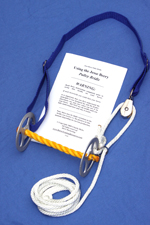“Wood Frogs, Possibilities and Horses”
In nature, there’s an amazing thing.
It’s the Wood frog.
It freezes solid in the winter and
thaws back to life in the spring.
That’s one of those things that make
you wonder how that’s even possible.
In fact, the horse world is full of
things that make you wonder how they’re poss-
bile.
If you ever watched a rider get a
horse doing things when it doesn’t look like
the rider is doing anything…that’s what I’m
talking about.
When we filmed Sarah Jarvis, she
showed how to do many of those things.
Click HERE For Your Sara Jarvis DVD
Sarah contends (and I agree) that
you don’t need to pull on a horse to get ’em
turning and stopping.
Horses don’t like to be pulled and
jerked on anyway.
So how do they know what to do when
you ask them?
It’s a process that teaches the horse
what to do when asked.
Most people don’t get that when you
ask a horse for something that they won’t do
it because they don’t know what you’re asking.
It is NOT (normally) because they’re
being belligerent.
So, you simply have to explain it to
them.
And you have to explain it in a way
they understand.
It has to be done often.
Once it’s been done again and again
and again, they start to get it pretty good
at it.
When Sarah shows how to teach a horse
to move off the slightest rein touch, she uses
a whip.
Fist, Sarah discusses the Direct and
Indirect Rein.
The Direct Rein is the rein used away
from the horse. Look for the hip to move away
to follow the rein.
Eventually, once he moves from the rein,
the rein returns back to neutral which is about
an inch or inch and a half from his neck.
When you move the rein away, reinforce
it with the whip by tapping on the horse.
The horse moves himself back to where
the rein is back to neutral position.
Then if the horse moves forward instead,
use the halt position where you turn the other
way. Elevate the lead rope, then ask for the
direct rein aid again.
Remember to ignore the negative and
reinforce the positive.
And as long it’s not life-threatening,
ignore it.
When you’ve taught this to your horse
something astonishing happens.
When you move your rein and get the
slightest contact on his neck, he moves his
head.
When I say slightest contact, I mean
as light as a fly touching him.
Horses can definitely feel that slight
contact. In fact, there’s a layer of muscle
just below the skin designed to feel the slightest
touch.
Click HERE For Your Sara Jarvis DVD
And when he follows his head after he’s
moved it you get that special effect of the
horse moving as if he’s reading your mind.
This is something I think many a horse
owner should try on their horse.
Why?
It teaches you that you don’t have to
pull on the horse.
It teaches you just how sensitive to
touch a horse really is.
It teaches you patience.
And…it’s fun to have your horse respond
to your rein aids like this.
Plus, it’s pretty easy to do.
If you want to try it, check out what
Sarah shows. Click on the following:
Click HERE For Your Sara Jarvis DVD
If done correctly, rein aids will
release themselves – it’s not a conscious
thing.
You set the rein, the horse moves,
the rein gets its own release.
Mission accomplished.
OK – that’s it for today – stay safe around your horses!
Charlie
P.S. Everything is currently in stock and ready to ship. We
frequently ship same day but always strive to ship next business
day in all cases. We ship USPS Priority so you’ll typically
get 2-3 day delivery.
P.P.S P.S. Please use the coupon code CHARLIEHORSE
and take 10% off any order. I’m keeping it
active for all customers who subscribe to
my horse tips emails for now.


